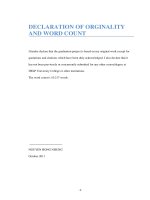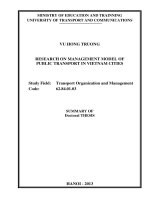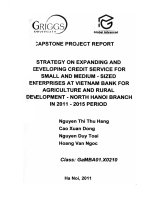Summary Doctoral thesis: Researching on enterprise knowledge management system to improve competitive advantages for small and medium enterprises in Vietnam
Bạn đang xem bản rút gọn của tài liệu. Xem và tải ngay bản đầy đủ của tài liệu tại đây (1.22 MB, 12 trang )
1
2
ABSTRACT
as well as organizational capacity for innovation didn’t consider and evaluate
all the factors which affect the competitive advantage.
1. Background
Nowadays, not only business is important but also knowledge is
increasing for the sustainable development of a business and in the nation.
Knowledge is considered to be meaningful and useful information of
personnel data, policies or operational process of each business
A Knowledge Management System includes information system,
operation system, decision system, unlike data management or information
management, knowledge management is creating, sharing, using and
developing the knowledge and information of an organization. The goal of
this site is to provide a comprehensive overview of knowledge management
by examining its objectives, scope, strategy, best practice, knowledge
management tools, and so on. Competitive advantage of enterprise is the
knowledge refine the firm’s information assets to meet organizational goals.
So, knowledge management is a key factor in each business.
Having many researchers explained the role and impact of knowledge
management in the company but the paper didn’t show some issues:
Firstly, in the SECI model, Nonaka (2011) found out that the process of
converting tacit knowledge into explicit knowledge. Base on the example of
specific companies, there are some effects or problem on the process of the
impact of knowledge management systems. How is the knowledge
management system sharing, training of staffs and employees in the
companies?
Secondly, Duska Rosenberg and Keith Devlin (2007) focused on the
development and application of an information based on the model that aims
to capture formally the explicit and implicit aspects of knowledge. This paper
did not explain the solution to the motives, ideas and different experience
among the staff in the companies. The researchers did not consider the
knowledge management systems on the effect on training, decision-making
Thirdly, All the papers which involve on Knowledge Management in
research of companies in the developed countries were having the good
training and the strategy for long-term growth. In Vietnam, other researches
showed that the knowledge maintenance model but not considering the
Knowledge Management; range of this researchers is limited to small and
medium enterprises that organization system is not transparent, lack of
leadership, business management skills and operation in economic
transformation are disqualified, focus on short-term goals. In the developing
countries, how business should solve knowledge management. When the
businesses have professional operation in the long-term, what they will do
with their employees with less soft skills, have less experience on
management in professional working environment.
Therefore, my paper gives more solutions of previous researches, I
choose the topic: “Research on Enterprise Knowledge Management system
to Improve Competitive Advantages for Small and Medium Enterprises in
Vietnam”.
2. Objective of research
Main objective: Building the model on the effect of Knowledge Management
System on the SME’s toward Competitive Advantage
Detail objective:
- Identifying the model and level of development on Knowledge
Management in the SME’s in Vietnam;
- Design Enterprise Architecture for Enterprise Knowledge Management
System.
- Building the influence model of Enterprise Knowledge Management
System to Competitive Advantage in the SME’s.
3
4
3. Subjects and Scope research
3.1. Subjects Research
5. Structure
Knowledge Management Business system to Competitive Advantage in the
SME’s Vietnam
My thesis is divided into four chapters:
3.2. Scope Research
Chapter 1: The issues between the Knowledge Management and Competitive
Advantage in SME’s in Vietnam
Spatial area of interest: The paper researches the SME’s in Vietnam
Chapter 2: The Knowledge Management System in SME’s in Vietnam
Temporal area of interest: Data from 2015 to 2016
Chapter 3: Design Enterprise Architecture for Knowledge Management
System in SME’s in Vietnam
Content of interest: The thesis investigates the realities, constitutes and the
impact of Knowledge management system to Competitive Advantage in
companies.
Chapter 4: The Knowledge Management System Model to make competitive
advantages for SME’s in Vietnam.
4. Methodology
6. New Contributions on the thesis
- Collecting Qualitative Data (qualitative – interview, quantitative or
combined)
New contributions in term of academic literature and theory:
I will randomly select companies such as state enterprises, private company,
joint venture, Foreign-Invested Enterprise in Vietnam and conduct a survey
using two methods: interview and questionnaires.
- Collecting Data
+ The interview method (personal Interview) is a face to face communication
between the researchers and the respondents e.g staffs, directors and partners
of the companies.
+ Questionnaire: The present study will use some questions as the
questionnaires to find the information related to the researches. If the
geographic is far away to use the interview method, researcher will use online
interview.
+ Analyzing data: Using SEM – Structural Equation Modeling to test the
estimates, exploratory factor analysis and suitability model.
+ Analyze or Design System: using the Enterprise Architecture structure.
- Predictive and test the Knowledge Management System Model of SME’s
Vietnam
- Building Enterprise Architecture for the Knowledge Management System
Model
- Giving the Impact Model of the Knowledge Management System to
Competitive Advantage
New recommendations:
- My thesis evaluates actual state of implementation of the Knowledge
Management System in SME’s Vietnam
- Knowledge Management System is being used and practice in some SME’s
Vietnam
5
CHAPTER 1. THE ISSUES BETWEEN THE KNOWLEDGE
MANAGEMENT AND COMPETITIVE ADVANTAGE IN SME’S IN
VIETNAM
In this chapter, I have already shown in the background of the issues
between the Knowledge Management and Competitive Advantage in SME’s
in Vietnam. The first, I indicate the fact of problem of SME’s in Vietnam.
The second, I introduce Competitive Advantages and Capacity in building
sustainable competitive advantages. The third, I give the overview of
Knowledge, types of Knowledge and Knowledge Management in companies.
The last, I explain analysis and evaluation to give the roles of Knowledge
Management in building the Competitive Advantages in SME’s.
1.1. Vietnam SMEs
Depending on the country, the size of the enterprise can be categorized
based on the number of employees, annual sales, assets, or any combination
of these. It may also vary from industry to industry.
1.2. Competitive Advantages
M.Porter (2004) explained that: “Competitive advantage is a function
of either providing comparable buyer value more efficiently than
competitors, or performing activities at comparable cost but in unique ways
that create more buyer value than competitors and, hence command a
premium price”. Competitive advantages are conditions that allow a company
to produce a good or service at equal value but at a lower price or in a more
desirable fashion. These conditions allow the productive entity to generate
more sales or superior margins compared to its market rivals. Competitive
advantages are attributed to a variety of factors including cost structure,
branding, the quality of product offerings, the distribution network,
intellectual property and customer service.
1.2.1. The definition of Competitive Advantage
1.2.2. Effect of Core Competence of Enterprises on Competitive Advantage
6
- Creation
- Adaptation
- Internalization
- Connection
- Knowledge
- Integrated Capacity
1.3. Knowledge Management in Enterprises
1.3.1. The definition of Knowledge
Sveiby (1997-1998) showed that “Knowledge is the ability to explain
and act something”.
Following Nonaka& Takeuchi (1995) indicated that “Knowledge is the
dynamic process of person to demonstrated faith of truths”. Davenport
&Prusak (1998) and Davanport (1999) gave the definition of Knowledge is
the information in your brain that the aggregation of experience, value,
context of information and specialist knowledge. These helps to evaluate and
coordinate to create new experiences and information including comparison,
results, contact and communication.
Stenmark (2001), Quigley and Debons (1999), Holsapple and Joshi
(2000) show that: “The brain transforms information into valuable
knowledge which helps us understanding the definitions by answer questions:
How? Know-How? Why? Know-Why?
1.3.2. Types of Knowledge
Nowadays, several definitions of knowledge and theories to explain it
exists. Knowledge dividends into many types such as: Individual Knowledge
and Group Knowledge, Tacit knowledge and Explicit knowledge.
1.3.3. Business knowledge
Business knowledge is a sum of skills, experiences, capabilities and
expert insight, which you collectively create and rely on in company. As a
7
8
shared resource, knowledge shapes and affects all the activities in and around
company.
- Combination: The creative use of computerized communication
networks and large-scale databases can support this mode of knowledge
conversion.
1.3.4. Knowledge Management in Business
Knowledge Management is a multidisciplinary assessing and several
definitions. Many researchers gave several definitions about Knowledge
management so had some confusion. Researchers gave two orientations:
human orientation and information technology orientation. Two orientations
show basic of approach, or researcher, organization and investigate
Knowledge management system, computer science, artificial intelligence.
There are definitions of both the approaches, but most of them focus on
human orientation and technology orientation is just supporting factors.
- Classification of Knowledge Management
+ From the learning organization to Knowledge management
+ From database to Knowledge management
- The process of Knowledge transfer
Tacit
Tacit
Socialization
Externalization
Explicit
Tacit
Internalization
Combination
Explicit
Explicit
- Environment of transfer knowledge
The theory of knowledge creation through the SECI process, and try to
advance them further incorporating the dialectic thinking. Knowledge is
conceptualized as a shared context in motion, can transcend time, space, and
organization boundaries to create knowledge. (Nonaka, 1991). Knowledge
creation is conceptualized as a dialectical process, in which various
contradictions are synthesized through dynamic interactions among
individual, the organization, and the environment.
In the knowledge-creating theory, Nonakael at gave the importance of
physical space or cyberspace of knowledge transfer environment interaction.
The environment of transfer knowledge is “a space that allows participants
share case and creation knowledge through interaction”
+ From traditional to knowledge work professions
Tacit
- Internalization: Transfers from explicit knowledge into tacit
knowledge held by the individual through the actual doing or through
simulations.
Explicit
Figure 1: SECI model of Nonaka
1.4. The role of knowledge management in creating competitive
advantage for SMEs
Many information system papers showed the effectiveness of
knowledge management systems (KMS) as the most advanced innovation in
the future. Davenport and Prusak (1998), Johnson (1998), Alavi and Leidner
(2001) indicated the importance of developing an organization’s KMS to
maintain competitive advantage in business environment.
Source: Nonaka,1991
- Socialization: Sharing tacit knowledge through face-to-face creation
or shared experience.
- Externalization: Tacit to explicit. Developing concepts, which embed
the combined tacit knowledge. And which enable its communication.
Knowledge management system in business, especially SMEs is
strategic to improve their competitiveness. It has four factors: rarer, nonimitate, valuate and irreplaceable, specifically: Creation capacity, adaptation
capacity, internalization capacity, connection capacity, knowledge capacity,
9
10
integrated Capacity. Thence, SMEs gives some competitive advantages
through methods:
CHAPTER 2. KNOWLEDGE MANAGEMENT SYSTEMS IN SMALL
AND MEDIUM ENTERPRISES IN VIETNAM
- Enhancing products
Knowledge management systems in small and medium enterprises in
Vietnam is considerably researched from the overview to that of detail. The
first part of the chapter, it presents an overview of the research school of
knowledge management systems. Besides, the authors examined the current
situation and determine the level of development of knowledge management
systems in small and medium enterprises in Vietnam. Finally, the author
proposed and tested model of factors affecting the knowledge management
systems in small and medium enterprises in Vietnam.
- Creating product differentiation
- Keeping customers
- Prevent competitors entering the market
- Increasing profits by reducing cost
Nowadays, information system is important components that helps
company maintaining their business goals and having competitive advantage
in the market. Information technology is an indispensable factor in the
strategy of company. SMEs should use knowledge management system
which is a useful tool to defeat such powerful opponents and attract more
customers with their brand positioning strategy.
2.1. Situation knowledge management systems in small and medium
enterprises in Vietnam
We have other with data management or information management and
knowledge management is understood as a process created, shared, exploited
and developed knowledge assets in enterprises in order to enhance the
effectiveness of the innovative capacity innovation and rapid response
capabilities of the business.
2.1.1. Schools of research on knowledge management system
2.1.1.1. Innovative diffusive theory
2.1.1.2. Reasonable action theory
2.1.1.3. Technology acceptance model
2.1.1.4. Theory of planning behavior
2.1.1.5. The fit between tasks-technology
2.1.1.6. Theory of social capital
2.1.1.7. Social awareness theory
2.1.1.8. Modeling success stories
2.1.1.9. Model of information system
2.1.2. Knowledge management system in small and medium enterprises
11
12
Knowledge Management System (KMS) includes g tools and
technology support and organizational problems. KMS is all of knowledge of
such organizations KMS consist of a current knowledge hidden, appeared,
made an creative and shared, stored and used. Therefore, it can be defined in
many different ways and applied in many areas of the organization of
activities related to human technology and processes.
2.1.3. Level of development of knowledge management system in small and
medium enterprises in Vietnam
Level of Knowledge Management
system in Vietnam’s SMEs
Level 5
12
Level 3
18
Level 2
27
Level 1
19
Level 0
According to Svetlana Sajeva & Robertas Jucevicius (2010),
knowledge management systems are characterized by six factors:
(1). Knowledge Management Process (KMP) Factor: KMP consists of 3
variables: Process Implementation and Coordination (KMP1), Process
Formulation (KMP2), Process Performance Measurement (KMP3).
(2). Strategy Leadership (SL): SL consists of 5 variables: SL1, SL2, SL3,
SL4, Reward and motivation (SL5).
(3). Organizational Structure (OI): Stacey (1995) states that the OI consists of
four variables: OI1, OI2, OI3, Social Networking (OI4).
4
Level 4
2.2.1. Model of enterprise knowledge management system
Level 0
Level 1
Level 2
Level 3
Level 4
Level 5
20
(4). Technology Infrastructure (TI) Factor: TI consists of three variables: the
existence of information and communication technology in line with business
development (TI1), access to information technology and business
communication (TI2), enterprises have regular application of information and
communication technologies (TI3).
(5). Academic Organization (OL): OL consists of three variables: learning
before knowledge management (OL1), learning in knowledge management
(OL2), learning after knowledge management (OL3).
(6). Organizational Culture (KC): The KC consists of 5 variables: KC1, KC2,
KC3, KC4, Culture of Culture, share knowledge (KC5).
Table 1: Cronbach's Alpha Scales of Variable Knowledge Management System
0
10
20
30
Figure 2: Graduation scale of Knowledge Management system
development in Vietnam’s SMEs
1. Graduation scale of knowledge management system development in small
and medium enterprises in Vietnam
2.2. Factors affecting knowledge management systems in small and medium
enterprises in Vietnam
Scale Mean if
Item Deleted
Scale
Corrected
Cronbach's
Variance if
Item-Total Alpha if Item
Item Deleted Correlation
Deleted
KMS (Cronbach's Alpha = 0.856)
KMS1
14.6000
9.899
.666
.828
KMS2
14.6900
10.054
.644
.834
KMS3
14.6300
9.852
.660
.830
KMS4
14.6700
9.294
.674
.827
KMS5
14.5300
9.524
.715
.815
13
14
2.2.3. Analyzing Discovery factors
2.2.5. Model validation
Table 2. Verify KMO and Bartlett's for independent variables
Kaiser-Meyer-Olkin Measure of Sampling Adequacy.
Bartlett's Test of
Sphericity
Approx. Chi-Square
Df
Sig.
0.717
881.136
After evaluating the scales, we test whether the model that t is suitable
by running on the Amos software. The resulting non-standardized model is
shown in Figure 3:
253
0.000
Coefficient of KMO = 0.717> 0.5: analyzing factors is appropriate for
research data. Bartlett's test result is 881,136 with significance level sig =
0.000 <0.05, so the factor model hypothesis is unsuitable and will be rejected,
which proves that the data used to analyze the factor is extremely appropriate.
2.2.4. Analyzing assertive factors
Figure 4. The non-standardized model
Figure 3. CFA results of variables Intention to share work experience
15
16
CHAPTER 3. DESIGN ENTERPRISE ARCHITECTURE FOR
KNOWLEDGE MANAGEMENT SYSTEM IN SME’S IN VIETNAM
Data Architecture: The structure of the physical data assets (text,
books, ...) and the logic (digital data) of the system and the tools for
managing this data asset.
Overall, I indicate the designing enterprise architecture for Knowledge
Management system. At first, I concentrate on the method of building model
for all of the information system, based on the result to evaluate, analyses and
select the Togaf way to create the overall model for Knowledge Management
system at SME’s in Vietnam. The next of content, showing the results of
building from the master to the detail of Knowledge Management system.
Finally, the experimental results, applied the overall model to develop and
implement at a specific business, is introduced
3.1 Enterprise architecture design method
"The enterprise architecture is known to be a set of principles, methods
and forms used to describe the organizational structure, business process,
infrastructure, information system or any constituent elements or any other
agency, organization, enterprise "according to Nguyen Minh Hong (2011).
Application Architecture: The overall design of the software
applications is used, the interaction between them and their relationship to the
main business processes of the system.
Technology Architecture: Describing the hardware and software
infrastructure which is vital in developing the three architectures. Technology
architecture includes: information technology infrastructure, middleware,
networking, communications, standards, etc.
System architectural framework: The architectural framework makes
general rules for the creation, interpretation, analysis and use of architectures
in a particular area of software or in the community that involved.
Begin
1. Operational
2. Collective
problems
The end
3. Exchange
6. Storage
Knowledge
database
4. Answer the
question and solve
problems
5. Appreciated
the answers
Figure 5. History of the enterprise architectures
3.2. Building the enterprise model for Knowledge Management System
Key components of that system
Business Process Architecture: including the development strategy,
management system, organizational structure, the main business processes of
a system.
Figure 6. Business Process Flow Diagram of Enterprise Knowledge
Management System
18
17
3.2 Business Process
Management System
Personal
Flow
Diagram of
Enterprise Knowledge
CHAPTER 4: THE KNOWLEDGE MANAGEMENT SYSTEM TO
MAKE COMPETITIVE ADVANTAGE FOR SME’S IN VIETNAM
Information System
Policies
Portal
The
Regulation Of
It Applications
In this chapter, I propose a model and test the impact of knowledge
management system to a competitive advantage SME’s in Vietnam. The
content is presented in detail from the design study model research methods
to test the model results. Thereby, finding out the inadequacy of knowledge
management in today's business, throughout analyzing to find the cause and
choosing a solution selection of optimal solutions and conducting building
system implementation knowledge management in the enterprise.
User Interface
Software
Training And
Supervision
Background Technology
Software
It
Data
Digitization
Database
Process
Operation
Infrastructure
Development
Strategy
Cooperate
Environment
Figure 7:. The IT architecture
3.3 Experimental building knowledge management system based on ERP
4.1. Question
Recent researches in the field of information systems appreciate greatly
the knowledge management system (KMS) as the important innovation to
enhance the operational efficiency of the business. Continuing upheaval of
the corporate market we always try to create and maintain competitive
advantage. Enterprises must effectively manage the resources of their unit
and one of the assets most important strategy that is knowledge (Nonaka
1995). Business knowledge may be found to be used and shared by decision
makers when they need it. There are many information technology systems
can effectively support the flow of knowledge. A system can the best support
the KMS line from which knowledge can improve the creativity popular
organizations collected knowledge (M. Alavi and D. Leidner 2001). In other
words, the KMS system has a great influence on the creation of competitive
advantage.
4.2. Designing research
Figure 8. Modules supported production and business operations
My thesis randomly selected businesses across the country operate in
the field of information and communications technology including the type of
public, private, venture and capital foreign investments, etc. It focusses
primarily on medium-sized enterprises and small and progress survey by two
methods of direct interviews and using questionnaires.
19
20
+ SEM method is used to test the model appropriately, weighted sum
CFA, reliability, unidirectional convergence and distribution value, ect
appreciate an influence on the degree of correlation with each other
independent factors
4.3. KMS model to CA
Decision making
process
- Tacit knowledge
- Explicit knowledge
- Cultural knowledge
4.5. Results of model testing
Cronch Alpha coefficient of variables
Knowledge
management
system
Learning
-Reliability
- Receipt
-Flexibility
-Organization
-Integration
-Creation
-Common
-Approach
- Product quality
Measurement Reliability Scores for each variable: Knowledge
Management System, Decision Process, Innovation Capacity, Learning
Ability and Competitive Advantage are summarized as follows:
- Market position
Table 3. Cronbach Alpha coefficients of variables
Competitive
advantage
- Diversify
products
No
- Difficult to
imitate
-In Time
- Administrative
procedures
Capacity of
innovation
Variable name
Identification
Number of Coefficient
observation Cronbach
Knowledge management
system
KMS
5
0.810
2 Decision making process
DMP
3
0.891
1
- Process innovation
3 Capacity of the organization
CO
2
0.770
- Product innovation
4 Learning ability
LA
4
0.914
5 Competitive advantage
CA
5
0.847
Figure 9. KMS model to CA
4.4. Research Methods
The study used analysis methods linear structure (Structural Equation
Modeling SEM-) to verify estimates explore factor analysis and the
appropriateness of the model
+ The first phase, it involves evaluating their selection interview
question survey to obtain data along-to-use analysis. Using quantitative
preliminary set sample initially test the correlation between the variables
correlated variables total inspection Cronbachs Alpha testing the factors
explored (EFA) which determine the pattern with the scale officially
Analyzing discovery factors
According to Hair &etc (1998, 111), KMO (Kaiser-Meyer-Olkin) is an
indicator of factor suitability. The KMO test results are as follows:
Table 4. KMO Coefficients
Accredited KMO and Bartlett
KMO Coefficients
Approx.Chi-Square
Bartlett form
df
Sig.
0.749
3665.765
171
.000
21
According to the analysis reuslt, the KMO coefficient = 0.749> 0.5: Factor
analysis is appropriate with the research data.
Analyzing the assertive factor
Results of the CFA model Chi-square Chi-squaredf df143 423 894 296 3
unsatisfactory (Carmines McIver 1981) worth 005 p 0000 is a perfect
fit. Other indicators show that this model fit the data research (CFI 0917 09
09 TLI RMSEA 089 008 0074). Components consist of: Systems Knowledge
Management, Learning Ability, decision process innovation capability and
competitive advantage are achieving unidirectional.
The correlation coefficient between the conceptual component is P-value ≤
0,05. Thus P-value components Knowledge Management System Learning
Ability decision process innovation capacity and competitive advantages are
achieved separated values special. The scale for the observed variables of
knowledge management system to achieve the convergence value.
Figure 10. Model affects KMS to CA
22
CONCLUSION
The dissertation has presented the realities of the development of
knowledge management systems in small and medium enterprises in
Vietnam. The most common level is the system that allows new employees in
the enterprise to perform old jobs using published business processes. This
system accounts for the highest rate of 27% and the optimized KMS system
accounts for the lowest rate of 4%. In the context of research being workers
in Vietnamese enterprises, where every employee has the need to learn from
other people experience, sharing, exchanging, learning the knowledge in
business is always on high demand. Corporate governors need to invest in the
knowledge management system development along with paying some
considerable attention to their staff: creating favorable conditions and
building incentive mechanism to encourage employees to actively learn and
pass on their experience; aiming at the goal of building a complete enterprise
knowledge management system that allows knowledge to be created, used,
shared and stored continuously to contribute to building sustainable
competitive advantage and enhancing efficiency - the fruit of the business.
Research results show that small and medium enterprises are aware of
the role that knowledge management plays in their production and business
activities. It can be emphasized that each component of the knowledge
management system can be characterized by different parameters. The
dissertation has proposed a number of factors that contribute to effective
management and are considered as an important condition for the successful
creation and development of knowledge management systems, the numerical
values of these results are used for small and medium enterprises.
However, simulation study for specific enterprises is more specific and
requires a more detailed analysis of the criteria of the parameters required for
the knowledge management system.
Knowledge is a valuable asset of the business that needs to be managed
properly, but it cannot be managed directly. Organizations can only create a
favorable environment by providing favorable conditions for workers to
23
engage in knowledge-based activities, creating an environment that a full
knowledge management system should be created and developed in the
organization. This research has examined 23 essential elements of knowledge
management systems, which are defined as factors that are needed when
developing a knowledge management system. However, it must be admitted
that these factors may be more detailed with more specific criteria for the
creation and development of a single knowledge management system in a
small and medium enterprise.
The dissertation has researched and rudimentarily evaluated in order to
select suitable architectural framework in the enterprise architecture for small
and medium enterprises in Vietnam. Specific results include: business
architecture, data architecture, application architecture, and technology
architecture from master to detail; which small and medium enterprises in
Vietnam can apply to develop and implement a knowledge management
system with a comprehensive vision, but specific to each function and data.
This research can be used by managers to assist enterprises in developing
strategies to enhance their competitive advantage. Enterprises should pay
attention to these key issues:
Aiming at the goal of building a complete knowledge management
system that allows knowledge to be created, used, shared and stored
continuously in all business operations.
Cohering the investment in knowledge management system
development together with creating favorable conditions to improve the
ability to learn and to innovate in the enterprise.
Strengthen the exploitation of the knowledge management system in all
activities of the enterprise, especially in decision-making, it is
necessary to thoroughly exploit sources of knowledge that have been
managed from the knowledge management system, such as hidden
knowledge and cultural knowledge.
Balancing the resources of the unit to reduce unnecessary learning
organization activities, increasing investment in the KMS system and
24
the capacity for innovation in order to create sustainable competitive
advantage and improve operational efficiency of the business.
To conclude, the dissertation focuses on researches into KMS and its
impact on decision-making, learning ability, business innovation and
competitive advantage. Knowledge management systems on one hand
create a favorable context that enables tacit knowledge to be interpreted
and shared, on the other hand allows and supports the transfer of
knowledge. Being limited by the sample size and the uneven use of KMS
in Vietnamese small and medium enterprises in the survey, the results of
this study still have some limitations. In the future, researches into the
impact of KMS on competitive advantage may be extended to take other
influencing factors into account, such as differences in information
quality, type of business, culture in regions, etc.









